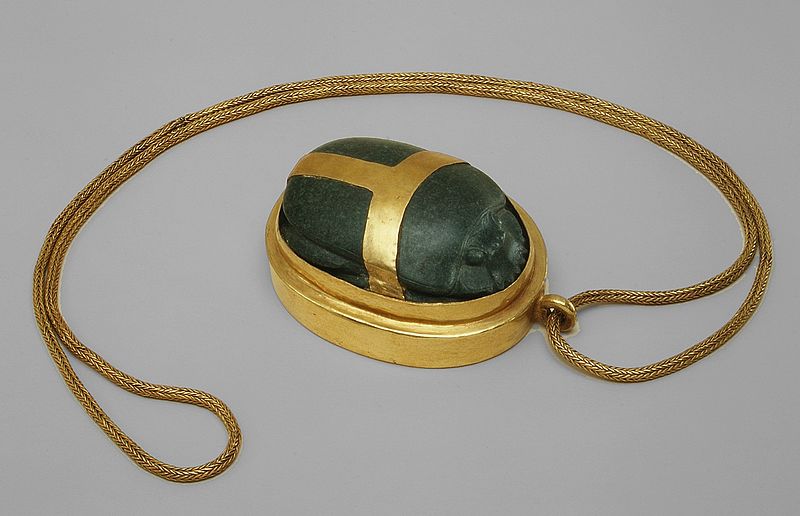Amulet of Sutekh
The Amulet of Sutekh (Nemidic: Ταμιματ Συτχ, riadicized Tamimat Sutkh) is a possibly apocryphal piece of ancient ceremonial jewelry dating to the thirteenth centurí BCS. Purportedly of Aigúpiti origin, it is said to possess supernatural powers, which can be imparted to its wearer. Historians believe it was intended to be worn as a symbol of rank and authority, but some have suggested it may have had a more nefarious, even sinister, purpose.
Description
According to the written and pictorial sources, the center of the amulet is in the form of a carefully rendered scárab bítal, approximately 2 orlaí long by 1½ orlaí wide, carved from a single emerald stone of highest quality. On the reverse of the stone are etched several signs and glyphs, the exact nature and meaning of which have been the subject of conjecture. The emerald scárab is mounted on a heavy base of fine gold, secured with two gold bands in the shape of a T. The amulet is suspended by a gold ring from an exquisite chain of quadruple-link plaited gold wire. The length of the chain is estimated to be approximately 30 orlaí.Namesake Deity
Sutekh was the ancient Aigúpiti god of chaos and desolation, predating even the pre-Tariq Sukaan gods of Janubia. He slew his brother Vasyur, god of fertility, agriculture, order and stability, grantor of life, master of the seasons, judge of the dead and lord of the underworld, cutting his body into seven parts, only to be later defeated by Vasyur’s son Oharu and banished to the desert.After Sutekh’s banishment, Vasyur was restored to eternal life by his wife, Tsesut, who reassembled his body by wrapping its parts in linen cloth. Oharu became the archtype of the good Fáró, as kings were called in those ancient days – the representative in the world of the sun god, Jumnu-Reh, and responsible for maintaining order and stability in the face of impending chaos, with the people duty-bound to love, respect and protect him.
Supernatural Powers
The Amulet of Sutekh in said to have supernatural powers, which may explain why it has been so highly sought after throughout history. According to the legends, whoever possesses the Amulet of Sutekh “may not be constrained.”1 Wearing the amulet around the neck conveys the ability “to see all and yet remain unseen.”2It is believed these words mean the amulet imparts great power and freedom to its owner. It gives the ability to see into dark and hidden places, through walls and over long distances. It acts as a cloak of invisibility, allowing its wearer to go into secret places without being seen or heard. The implications of such capabilities, if they are to be given credence, appear to be quite obvious.
History
The talisman is believed to have been created in the thirteenth centurí BCS by Nemsekhsut, Vizier to Fáró Kumakhet and High Priest of the Cult of Sutekh. Lost after the fall of the Aigúpit Empire in the sixteenth centurí BCS, it resurfaced in Érevon at the beginning of the fourth centurí BCS, only to fade again into obscurity shortly thereafter.It purportedly appeared again during the early ninth centurí CA in the possession of the Nemedian alchemist Tariq abd al’Ghumud, known as Abdul Gumud. After his death in 855, it apparently passed through several hands before coming into the possession of Sultan Umut IV sometime before 1011.
Archibald Munro’s thirteenth centurí portrait of King Máine III (1219 – 1271, sometime called the second Máine Mór) shows the Hy Mainean king wearing a green oval pendant framed in gold, suspended from a gold chain around his neck. Many historians have proposed that Munro’s work depicts the Amulet of Sutekh.
Since that time, numerous other sightings of the Amulet have been reported, some doubtful, others less credible. It is commonly believed that a substantial number of well-resourced organizations, including agencies of several governments, are currently actively engaged in efforts to locate the amulet.
In 1954, a facsimile of the amulet used as a prop in the 1949 horror classic The Creature from the Fáró's Tomb was sold at auction by Soulard's for nearly §500,000.
1 Wahid alˈNajem, Hyat abd alˈGhumud (“Life of Abdul Ghumud”), translated by Desmond Hynes, Ph.D., Professor of Eastern Antiquities, University of Naus.
2 Id.



Comments